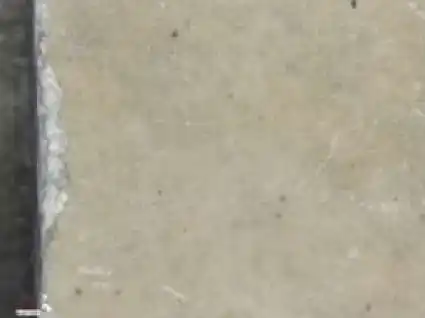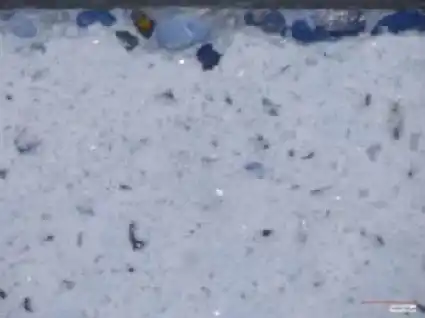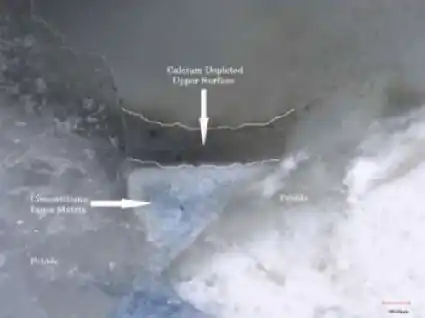
What happened to my pool’s interior finish color?
based on:
NPC Technical Bulletin #4 – The Most Common Reasons for Loss of Color
Here are the three most common causes of color loss:
1. Calcium salt migration due to cement hydration (pigment masking)
Pigment masking usually happens within the first three days after the pool is filled with water. The cause, cement hydration, is the chemical reaction that converts dry cement (powdered) materials and water into a rigid material, or binder. About 70 percent of cement hydration occurs within the first seven days of application, with additional hydration occurring slowly over many months. The cement hydration reaction produces a byproduct, calcium hydroxide (also called ‘plaster dust’), which can migrate through the finish coating. These salt ions can form on the surface, creating a white crystalline deposit that can cover or mask the finish color. Pigment masking can be avoided by following proper start-up procedures. It’s important to remove any plaster dust that migrates to the surface by frequent brushing of the pool finish and filtering the material out of the pool water within the first seven after the pool is filled. If filtering is not done, this dusty substance may adhere to the cement surfaces and can be very difficult and expensive to remove.
TOP VIEW

SIDE VIEW

CALCIUM SALT MIGRATION DUE TO CEMENT HYDRATION (PIGMENT MASKING)
2. Precipitation of minerals or metals (surface scaling)
Cementitious coatings, concrete, brick, metal, tile, and glass surfaces are all subject to salt scale and staining from minerals or metals depositing onto these surfaces from the pool water. Surface scaling appears as a white or light-colored film or layer that can dull or completely mask the intended finish color of your pool. Metals in the water can also alter the surface color by staining the finish. Copper and manganese can cause blue, green, or black staining. Iron can cause red, orange, or black staining. Staining and scaling issues can be avoided by periodic pool water testing for metals and hardness, by avoiding high concentrations of metals or mineral salts that can ruin the intended finish color. Chemicals (called chelates or sequestrants) may be used to counteract metals or mineral to prevent staining; however once started, these chemicals must be used continuously to neutralize new metals or mineral salts coming from the ongoing new fill water.
TOP VIEW

SIDE VIEW

PRECIPITATION OF MINERALS OR METALS (SURFACE SCALING)
3. Dissolution of cement compounds (pigment loss)
Water chemistry greatly affects the life expectancy of a pool’s cementitious coating and finish, including pigment loss. Whenever water permeates through a cementitious coating and water chemistry that is not maintained in a balanced “ideal range” (as defined by ANSI/PHTA**) aggressive water can result in chemical compounds dissolving or leaching of cement compounds at the surface, leading to pigment loss, and fading of the color at the surface of the finish.
When the surface begins to deteriorate the organic pigments are more vulnerable because they have a much smaller particle size than inorganic pigments. This makes them more likely to be released and lost from the cement’s binder as it becomes ever-more porous from ongoing deterioration from water chemistry imbalances. Initially, this loss of pigment appears as faded areas, or lighter blotchy areas, but can lead to white areas of complete pigment loss across the pool surface. The resulting color loss is irreversible once bad water chemistry causes pigment leaching – even the leaching of an eighth inch (1/8″) in depth will cause the loss of pigment and ruin the finish! “Aggressive” water chemistry includes water with low calcium hardness, low pH, low carbonate alkalinity, or a combination of these.
TOP VIEW

SIDE VIEW

DISSOLUTION OF CEMENT COMPOUNDS (PIGMENT LOSS)
Contact the National Plasterers Council for expert pool professionals in your area Pool professionals who are members of the National Plasterers Council will ensure that the interior finish is applied properly. They are also knowledgeable about start-up procedures, and the necessary ongoing care, maintenance, and water chemistry that ensures your pool’s finish and color will look beautiful for years to come!
* Based on NPC Technical Bulletin #4 – “The Most Common Reasons for Loss of Color”
**ANSI is the American National Standards Institute, www.ansi.org; PHTA is the Pool and Hot Tub Alliance, www.phta.org.
